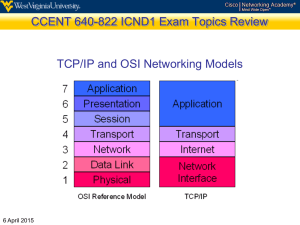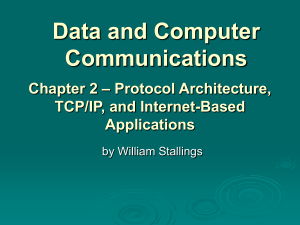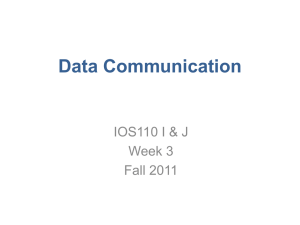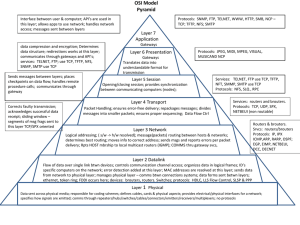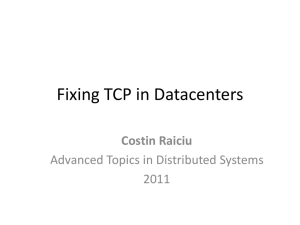tcp
advertisement
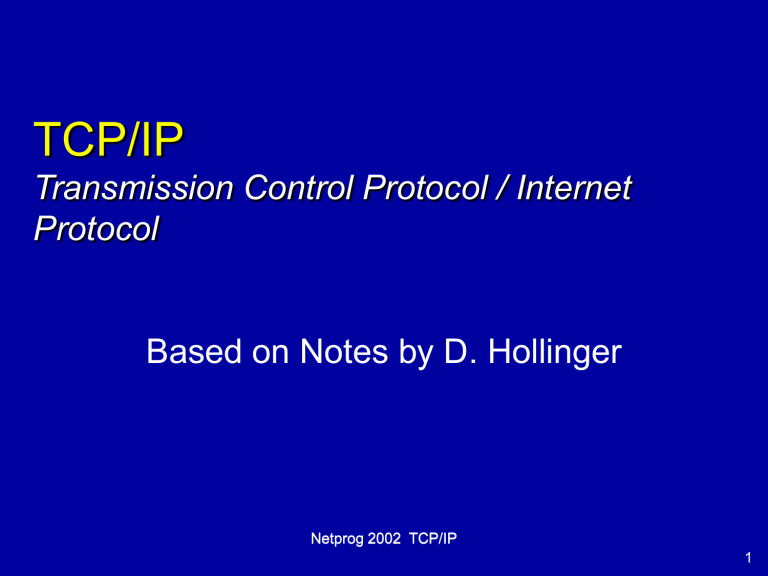
TCP/IP Transmission Control Protocol / Internet Protocol Based on Notes by D. Hollinger Netprog 2002 TCP/IP 1 Topics • IPv6 • TCP • Java TCP Programming Netprog 2002 TCP/IP 2 IPv6 availability • Generally available with (new) versions of most operating systems. • BSD, Linux 2.2 Solaris 8 • An option with Windows 2000/NT • Most routers can support IPV6 • Supported in J2SDK/JRE 1.4 Netprog 2002 TCP/IP 3 IPv6 Design Issues • Overcome IPv4 scaling problem • lack of address space. • Flexible transition mechanism. • New routing capabilities. • Quality of service. • Security. • Ability to add features in the future. Netprog 2002 TCP/IP 4 IPv6 Headers • Simpler header - faster processing by routers. • No optional fields - fixed size (40 bytes) • No fragmentation fields. • No checksum • Support for multiple headers • more flexible than simple “protocol” field. Netprog 2002 TCP/IP 5 4 for IPv4 IPv4 Header 1 byte 1 byte 1 byte 1 byte VERS HL Service Fragment Length Datagram ID FLAG Fragment Offset TTL Protocol Header Checksum Source Address Destination Address Options (if any) Data Netprog 2002 TCP/IP 6 6 for IPv6 IPv6 Header 1 byte 1 byte VERS PRIO Payload Length 1 byte 1 byte Flow Label Next Header Hop Limit Source Address (128 bits - 16 bytes) Dest. Address (128 bits - 16 bytes) Netprog 2002 TCP/IP 7 IPv6 Header Fields • VERS: 6 (IP version number) • Priority: will be used in congestion control • Flow Label: experimental - sender can label a • sequence of packets as being in the same flow. Payload Length: number of bytes in everything following the 40 byte header (up to 64Kb), or 0 for a Jumbogram (up to 4Gb). Netprog 2002 TCP/IP 8 IPv6 Header Fields • Next Header is similar to the IPv4 “protocol” field - indicates what type of header follows the IPv6 header. • Hop Limit is similar to the IPv4 TTL field (but now it really means hops, not time). Netprog 2002 TCP/IP 9 Extension Headers • Routing Header - source routing • Fragmentation Header - supports • • fragmentation of IPv6 datagrams. Authentication Header Encapsulating Security Payload Header Netprog 2002 TCP/IP 10 IPv6 Addresses • 128 bits - written as eight 16-bit hex numbers. 5f1b:df00:ce3e:e200:0020:0800:2078:e3e3 • High order bits determine the type of address. Netprog 2002 TCP/IP 11 IPv6 Aggregate Global Unicast Address 3 13 010 TLA ID 32 16 64 NLA ID SLA ID Interface ID TLA: top-level aggregation (provider) NLA: next-level (subscriber) SLA: site-level (subnet) Interface ID is (typically) based on hardware MAC address Netprog 2002 TCP/IP 12 IPv4-Mapped IPv6 Address • IPv4-Mapped addresses allow a host that support both IPv4 and IPv6 to communicate with a host that supports only IPv4. • The IPv6 address is based completely on the IPv4 address. Netprog 2002 TCP/IP 13 IPv4-Mapped IPv6 Address • 80 bits of 0s followed by 16 bits of ones, followed by a 32 bit IPv4 Address: 0000 . . . 0000 FFFF IPv4 Address 80 bits 16 bits 32 bits Netprog 2002 TCP/IP 14 Works with DNS • An IPv6 application asks DNS for the • • address of a host, but the host only has an IPv4 address. DNS creates the IPv4-Mapped IPv6 address automatically. Kernel understands this is a special address and really uses IPv4 communication. Netprog 2002 TCP/IP 15 IPv4-Compatible IPv6 Address • An IPv4 compatible address allows a • host supporting IPv6 to talk IPv6 even if the local router(s) don’t talk IPv6. IPv4 compatible addresses tell endpoint software to create a tunnel by encapsulating the IPv6 packet in an IPv4 packet. Netprog 2002 TCP/IP 16 IPv4-Compatible IPv6 Address • 80 bits of 0s followed by 16 bits of 0s, followed by a 32 bit IPv4 Address: 0000 . . . 0000 0000 IPv4 Address 80 bits 16 bits 32 bits Netprog 2002 TCP/IP 17 Tunneling (done automatically by kernel when IPv4-Compatible IPv6 addresses used) IPv6 Host IPv6 Host IPv4 Routers IPv4 Datagram IPv6 Datagram Netprog 2002 TCP/IP 18 IPv6 in Java 1.4 • Inet6Address class • :: corresponds to 0.0.0.0 (unspecified) in IPv4 • ::1 corresponds to 127.0.0.1 (loopback) in IPv4 • ::ffff:w.x.y.z IPv4-mapped address • ::w.x.y.z to tunnel IPv6 packets over IPv4 routing • For details, see: http://java.sun.com/j2se/1.4/docs/guide/net/ipv6_guide/ Netprog 2002 TCP/IP 19 TCP Transmission Control Protocol • TCP is an alternative transport layer • protocol over IP. TCP provides: Connection-oriented Reliable Full-duplex Byte-Stream • • • • Netprog 2002 TCP/IP 20 Connection-Oriented • Connection oriented means that a • • virtual connection is established before any user data is transferred. If the connection cannot be established - the user program is notified. If the connection is ever interrupted - the user program(s) is notified. Netprog 2002 TCP/IP 21 Reliable • Reliable means that every • transmission of data is acknowledged by the receiver. If the sender does not receive acknowledgement within a specified amount of time, the sender retransmits the data. Netprog 2002 TCP/IP 22 Byte Stream • Stream means that the connection is treated as a stream of bytes. • The user application does not need to package data in individual datagrams (as with UDP). Netprog 2002 TCP/IP 23 Buffering • TCP is responsible for buffering data and determining when it is time to send a datagram. • It is possible for an application to tell TCP to send the data it has buffered without waiting for a buffer to fill up. Netprog 2002 TCP/IP 24 Full Duplex • TCP provides transfer in both directions. • To the application program these appear as 2 unrelated data streams, although TCP can piggyback control and data communication by providing control information (such as an ACK) along with user data. Netprog 2002 TCP/IP 25 TCP Ports • Interprocess communication via TCP is achieved with the use of ports (just like UDP). • UDP ports have no relation to TCP ports (different name spaces). Netprog 2002 TCP/IP 26 TCP Segments • The chunk of data that TCP asks IP to deliver is called a TCP segment. • Each segment contains: • data bytes from the byte stream • control information that identifies the data bytes Netprog 2002 TCP/IP 27 TCP Segment Format 1 byte 1 byte 1 byte 1 byte Source Port Destination Port Sequence Number Acknowledgment Number offset Reser. Control Window Checksum Urgent Pointer Options (if any) Data Netprog 2002 TCP/IP 28 TCP Lingo • When a client requests a connection it • • sends a “SYN” segment (a special TCP segment) to the server port. SYN stands for synchronize. The SYN message includes the client’s ISN. ISN is Initial Sequence Number. Netprog 2002 TCP/IP 29 More... • Every TCP segment includes a • Sequence Number that refers to the first byte of data included in the segment. Every TCP segment includes an Acknowledgement Number that indicates the byte number of the next data that is expected to be received. • All bytes up through this number have already been received. Netprog 2002 TCP/IP 30 And more... • There are a bunch of control flags: • URG: urgent data included. • ACK: this segment is (among other things) • • • an acknowledgement. RST: error – connection must be reset. SYN: synchronize Sequence Numbers (setup) FIN: polite connection termination. Netprog 2002 TCP/IP 31 And more... • MSS: Maximum segment size (A TCP • option) Window: Every ACK includes a Window field that tells the sender how many bytes it can send before the receiver will have to toss it away (due to fixed buffer size). Netprog 2002 TCP/IP 32 TCP Connection Creation • Programming details later - for now we • are concerned with the actual communication. A server accepts a connection. • Must be looking for new connections! • A client requests a connection. • Must know where the server is! Netprog 2002 TCP/IP 33 Client Starts • A client starts by sending a SYN segment with the following information: • Client’s ISN (generated pseudo-randomly) • Maximum Receive Window for client. • Optionally (but usually) MSS (largest • datagram accepted). No payload! (Only TCP headers) Netprog 2002 TCP/IP 34 Server Response • When a waiting server sees a new connection request, the server sends back a SYN segment with: • Server’s ISN (generated pseudo-randomly) • Request Number is Client ISN+1 • Maximum Receive Window for server. • Optionally (but usually) MSS • No payload! (Only TCP headers) Netprog 2002 TCP/IP 35 Finally • When the Server’s SYN is received, the client sends back an ACK with: • Acknowledgment Number is Server’s ISN+1 Netprog 2002 TCP/IP 36 Server Client SYN ISN=X 1 2 SYN ISN=Y ACK=X+1 ACK=Y+1 3 Netprog 2002 TCP/IP 37 TCP 3-way handshake 1 Client: “I want to talk, and I’m starting with byte number X”. 2 Server: “OK, I’m here and I’ll talk. My first byte will be called number Y, and I know your first byte will be number X+1”. 3 Client: “Got it - you start at byte number Y+1”. ? Bill: “Monica, I’m afraid I’ll syn and byte your ack” Netprog 2002 TCP/IP 38 Why 3-Way? • Why is the third message necessary? • HINTS: • TCP is a reliable service. • IP delivers each TCP segment. • IP is not reliable. Netprog 2002 TCP/IP 39 TCP Data and ACK • Once the connection is established, • • data can be sent. Each data segment includes a sequence number identifying the first byte in the segment. Each segment (data or empty) includes a request number indicating what data has been received. Netprog 2002 TCP/IP 40 Buffering • Keep in mind that TCP is part of the • • Operating System. The O.S. takes care of all these details asynchronously. The TCP layer doesn’t know when the application will ask for any received data. TCP buffers incoming data so it’s ready when we ask for it. Netprog 2002 TCP/IP 41 TCP Buffers • Both the client and server allocate buffers to hold incoming and outgoing data • The TCP layer does this. • Both the client and server announce with every ACK how much buffer space remains (the Window field in a TCP segment). Netprog 2002 TCP/IP 42 Send Buffers • The application gives the TCP layer • • some data to send. The data is put in a send buffer, where it stays until the data is ACK’d. The TCP layer won’t accept data from the application unless (or until) there is buffer space. Netprog 2002 TCP/IP 43 ACKs • A receiver doesn’t have to ACK every • • segment (it can ACK many segments with a single ACK segment). Each ACK can also contain outgoing data (piggybacking). If a sender doesn’t get an ACK after some time limit, it resends the data. Netprog 2002 TCP/IP 44 TCP Segment Order • Most TCP implementations will accept • • out-of-order segments (if there is room in the buffer). Once the missing segments arrive, a single ACK can be sent for the whole thing. Remember: IP delivers TCP segments, and IP is not reliable - IP datagrams can be lost or arrive out of order. Netprog 2002 TCP/IP 45 Termination • The TCP layer can send a RST • segment that terminates a connection if something is wrong. Usually the application tells TCP to terminate the connection politely with a FIN segment. Netprog 2002 TCP/IP 46 FIN • Either end of the connection can initiate • • • • termination. A FIN is sent, which means the application is done sending data. The FIN is ACK’d. The other end must now send a FIN. That FIN must be ACK’d. Netprog 2002 TCP/IP 47 App2 App1 FIN SN=X 2 ... ACK=X+1 1 FIN SN=Y 3 ACK=Y+1 4 Netprog 2002 TCP/IP 48 TCP Termination 1 App1: “I have no more data for you”. 2 App2: “OK, I understand you are done sending.” dramatic pause… 3 App2: “OK - Now I’m also done sending data”. 4 App1: “Roger, Over and Out, Goodbye, Hastalavista Baby, Adios, It’s been real ...” camera fades to black ... Netprog 2002 TCP/IP 49 TCP TIME_WAIT • Once a TCP connection has been terminated (the last ACK sent) there is some unfinished business: • What if the ACK is lost? The last FIN will be • resent and it must be ACK’d. What if there are lost or duplicated segments that finally reach the destination after a long delay? • TCP hangs out for a while to handle these situations. Netprog 2002 TCP/IP 50 TCP Sockets Programming • Creating a passive mode (server) • • • socket. Establishing an application-level connection. Sending/receiving data. Terminating a connection. Netprog 2002 TCP/IP 51 Establishing a passive mode TCP socket Passive mode: • Address already determined. • Tell the kernel to accept incoming connection requests directed at the socket address. • 3-way handshake • Tell the kernel to queue incoming connections for us. Netprog 2002 TCP/IP 52 Accepting an incoming connection. • Once we start listening on a socket, the O.S. will queue incoming connections • Handles the 3-way handshake • Queues up multiple connections. • When our application is ready to handle a new connection, we need to ask the O.S. for the next connection. Netprog 2002 TCP/IP 53 Terminating a TCP connection • Either end of the connection can call the close() system call. • If the other end has closed the connection, and there is no buffered data, reading from a TCP socket returns 0 to indicate EOF. Netprog 2002 TCP/IP 54 Client Code • TCP clients can connect to a server, which: • takes care of establishing an endpoint address for the client socket. • don’t need to call bind first, the O.S. will take care of assigning the local endpoint address (TCP port number, IP address). • Attempts to establish a connection to the specified server. • 3-way handshake Netprog 2002 TCP/IP 55 Reading from a TCP socket • By default read() will block until data is • • available. Reading from a TCP socket may return less than max bytes (whatever is available). You must be prepared to read data 1 byte at a time! Netprog 2002 TCP/IP 56 Writing to a TCP socket • write might not be able to write all bytes (on a nonblocking socket). Netprog 2002 TCP/IP 57 Metaphor for Good Relationships Copyright Dr. Laura’s Network Programming Corp. To succeed in relationships: • you need to establish your own identity. • you need to be open & accepting. • you need to establish contacts. • you need to take things as they come, not as you expect them. • you need to handle problems as they arise. Netprog 2002 TCP/IP 58 Java Sockets Programming • The package java.net provides support • for sockets programming Typically you import everything defined in this package with: import java.net.*; Netprog 2002 TCP/IP 59 Classes InetAddress Socket ServerSocket DatagramSocket DatagramPacket UDP Netprog 2002 TCP/IP 60 Socket class • Corresponds to active TCP sockets only! • client sockets • socket returned by accept(); • Passive sockets are supported by a different class: ServerSocket Netprog 2002 TCP/IP 61 Socket Constructors • Constructor creates a TCP connection to a named TCP server. • There are a number of constructors: Socket(InetAddress server, int port); Socket(InetAddress server, int port, InetAddress local, int localport); Socket(String hostname, int port); Netprog 2002 TCP/IP 62 Socket Methods void close(); InetAddress getInetAddress(); getpeername InetAddress getLocalAddress(); getsockname InputStream getInputStream(); OutputStream getOutputStream(); • Lots more (setting/gettting socket options, partial close, etc.) Netprog 2002 TCP/IP 63 Socket I/O • Socket I/O is based on the Java I/O support (in the package java.io). • InputStream and OutputStream are abstract classes • common operations defined for all kinds of InputStreams, OutputStreams… Netprog 2002 TCP/IP 64 ServerSocket Class (TCP Passive Socket) • Constructors: ServerSocket(int port); ServerSocket(int port, int backlog); ServerSocket(int port, int backlog, InetAddress bindAddr); Netprog 2002 TCP/IP 65 ServerSocket Methods Socket accept(); void close(); InetAddress getInetAddress(); int getLocalPort(); throw IOException, SecurityException Netprog 2002 TCP/IP 66 Sample Echo Server TCPEchoServer.java, EchoClient.java, GenericClient.java Simple TCP Echo server. Based on code from: TCP/IP Sockets in Java, Java Online Tutorial Netprog 2002 TCP/IP 67




